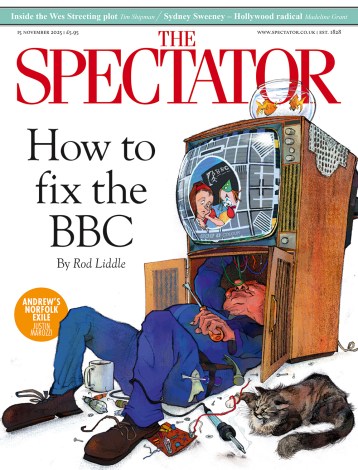Doggy sounds childish. ‘How much is that doggie in the window?’ asks the popular song. (The song title used the spelling doggie, being American, though Britain enjoyed a cover version by Lita Roza in 1953, the same year as Patti Page’s original.). Doggo sounds cooler (like daddy-o in hep talk), but in the strange world of internet image-sharing it goes with a sentimentality which would shame the nursery.
The internet has said ‘Aaah’ (or in America ‘Aaaw’) to cute cats, but people post pictures a-plenty of cute dogs. One Twitter account, WeRateDogs, has 8.13 million followers and simply tweets photos of dogs with a caption and a rating out of ten. Like the 110 per cent that employees are asked to give, its ratings exceed the maximum. So, under a picture of a dog in a mortarboard, a caption reads: ‘This is Pake. His parents just graduated and he was feeling a little left out. Not any more. 14/10 barkalaureate inbound.’
Worse, to my mind, are brave dogs at the vet’s: ‘This is Taíno. He was found on the side of a road in Puerto Rico. It’s possible he was hit by a car, as his front right leg is severely deformed. He’s having surgery to correct it.’ Sickening.
On Facebook, a group called Dogspotting also shares cute pictures. Members learn a common jargon, calling dogs doggos, or puppers if they are young. An overweight dog may be a loaf or fat boi.
Fluffy dogs are called fluffers or floofs. A bark is a bork and onomatopoeic words denote chop-licking (mlem) or tongue-lolling (blop). As an intensive (like very), heckin is used, sometimes spelled h*ckin. Heckin derives from another internet pastime: ‘interior monologue captioning’ of animal pictures. It’s the animal speaking, or thinking. Often the spelling is deliberately erroneous, to be lovably childish: fren for friend, henlo for hello and snek for snake. An early success in interior monologue captioning was a snake on Facebook in 2015 captioned ‘scuse bitch why u touch’.
Anyway, despite an extent less than a German shepherd’s mlem, the language of cute social media dog sites is known as DoggoLingo. It’s as well to be aware of such things.






Comments